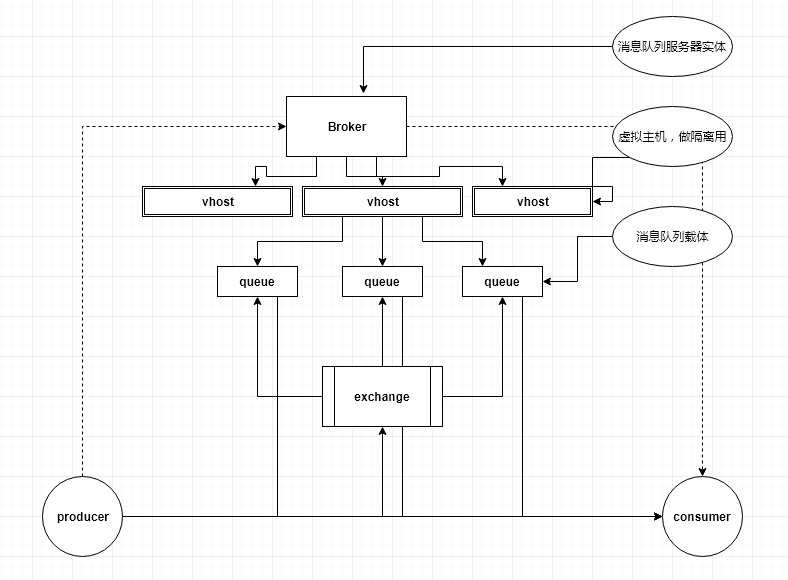概念:RabbitMQ是一款开源的消息中间件系统,由erlang开发,是AMQP的实现。

架构图大概如上。
broker是消息队列的服务器,比如在linux上,我们安装的rabbitmq就是一个broker,可以通过url+username+password连接。
每个消息服务器可以创建多个vhost,默认的vhost是“/”,linux中通过rabbitmqctl add_vhost <vhost> 创建vhost,再给指定用户授权即可。
生产者首先通过创建channel与broker连接,类似于创建一个会话,这样可以与消息主机通信发送消息。
消息生产者将消息发送到定义的exchange上,exchange通过不同的转发路由规则将消息转发到相应的队列,消费者选择一个队列监听,如果有多个消费者监听同一个队列,默认是轮询方式,保证每个连接有相同的收到消息的概率。
一个简单的rabbitmq程序:
public class Producer {
private static final String TEST_VHOST = "testvhost";
private static final String TEST_QUEUE_NAME = "task_queue";
private static Connection connection;
private static Channel channel;
public static void main(String[] args) throws IOException, TimeoutException, RabbitmqConnectionException {
try {
//create connectionFactory with host, username, password, vhost.
ConnectionFactory connectionFactory = new ConnectionFactory();
connectionFactory.setUsername("test");
connectionFactory.setPassword("test");
connectionFactory.setHost("localhost");
connectionFactory.setVirtualHost(TEST_VHOST);
//get connection from connectionFactory
connection = connectionFactory.newConnection();
//create an session to communicate with mq host
channel = connection.createChannel();
//declare a queue(if not exists, create it)
channel.queueDeclare(TEST_QUEUE_NAME, true, false, false, null);
String message = "Hello world";
System.out.println("sending message : " + message);
//publish message to the declaring queue
channel.basicPublish("", TEST_QUEUE_NAME, MessageProperties.PERSISTENT_TEXT_PLAIN, message.getBytes());
}catch (Exception e) {
throw new RabbitmqConnectionException("Error connection");
} finally {
channel.close();
connection.close();
}
}
}
public class Consumer {
private static final String TEST_VHOST = "testvhost";
private static final String TEST_QUEUE_NAME = "task_queue";
public static void main(String[] argv) throws Exception {
ConnectionFactory factory = new ConnectionFactory();
factory.setHost("localhost");
factory.setVirtualHost(TEST_VHOST);
factory.setUsername("test");
factory.setPassword("test");
final Connection connection = factory.newConnection();
final Channel channel = connection.createChannel();
//declaring a queue to listen
channel.queueDeclare(TEST_QUEUE_NAME, true, false, false, null);
System.out.println("Waiting for messages...");
//a piece message per time
channel.basicQos(1);
final com.rabbitmq.client.Consumer consumer = new DefaultConsumer(channel) {
@Override
public void handleDelivery(String consumerTag, Envelope envelope, AMQP.BasicProperties properties, byte[] body) throws IOException {
String message = new String(body, "UTF-8");
System.out.println("Received : '" + message + "'");
channel.basicAck(envelope.getDeliveryTag(), false);
}
};
channel.basicConsume(TEST_QUEUE_NAME, false, consumer);
}
}
在spring中:
<!-- spring-rabbitmq.xml--> <?xml version="1.0" encoding="UTF-8"?> <beans xmlns="http://www.springframework.org/schema/beans" xmlns:xsi="http://www.w3.org/2001/XMLSchema-instance" xmlns:rabbit="http://www.springframework.org/schema/rabbit" xmlns:mvc="http://www.springframework.org/schema/context" xsi:schemaLocation="http://www.springframework.org/schema/beans http://www.springframework.org/schema/beans/spring-beans.xsd http://www.springframework.org/schema/rabbit http://www.springframework.org/schema/rabbit/spring-rabbit.xsd http://www.springframework.org/schema/context http://www.springframework.org/schema/context/spring-context.xsd"> <description>rabbitmq 连接服务配置</description> <mvc:component-scan base-package="com.battery.rabbitMq"/> <!-- 连接配置 --> <rabbit:connection-factory id="rabbit-connectionFactory" host="${mq.host}" username="${mq.username}" password="${mq.password}" port="${mq.port}" virtual-host="${mq.vhost}"/> <rabbit:admin connection-factory="rabbit-connectionFactory"/> <!-- spring template声明,注入到类中,用于将消息发送到指定队列--> <rabbit:template exchange="test-mq-fanout" id="ssoTemplate" connection-factory="rabbit-connectionFactory" message-converter="jsonMessageConverter" /> <!-- 消息对象json转换类 --> <bean id="jsonMessageConverter" class="org.springframework.amqp.support.converter.Jackson2JsonMessageConverter" /> <!-- 声明一个消息队列( durable:是否持久化 exclusive: 仅创建者可以使用的私有队列,断开后自动删除 auto_delete: 当所有消费客户端连接断开后,是否自动删除队列) --> <rabbit:queue id="test_queue" name="test_queue" durable="true" auto-delete="false" exclusive="false" /> <!-- 定义交换机 rabbit:direct-exchange:定义exchange模式为direct,意思就是消息与一个特定的路由键完全匹配,才会转发。 rabbit:binding:设置消息queue匹配的key --> <rabbit:fanout-exchange name="test-mq-fanout" auto-declare="true" durable="true" auto-delete="false" id="test-mq-fanout"> <rabbit:bindings> <rabbit:binding queue="test_queue"/> </rabbit:bindings> </rabbit:fanout-exchange> <!-- 消费者配置 --> <!-- 队列监听类 --> <bean id="queueListener" class="com.battery.rabbitMq.QueueListener"/> <!-- 监听容器配置 --> <rabbit:listener-container connection-factory="rabbit-connectionFactory" acknowledge="manual"> <rabbit:listener queues="test_queue" ref="queueListener" method="onMessage"/> </rabbit:listener-container> </beans>
@Service
public class MQProducerImpl implements MQProducer {
@Autowired
private RabbitTemplate rabbitTemplate;
private final static Logger LOGGER = LoggerFactory.getLogger(MQProducerImpl.class);
/**
* convertAndSend:将Java对象转换为消息发送到匹配Key的交换机中Exchange,由于配置了JSON转换,这里是将Java对象转换成JSON字符串的形式。
* 原文:Convert a Java object to an Amqp Message and send it to a default exchange with a specific routing key.
**/
@Override
public void sendDataToQueue(Object object) {
try {
rabbitTemplate.convertAndSend(object);
} catch (Exception e) {
LOGGER.error(e.getMessage());
}
}
}
@Component public class QueueListener implements ChannelAwareMessageListener { private static Logger logger = LoggerFactory.getLogger(QueueListener.class); @Override public void onMessage(Message message, Channel channel) throws Exception { try { String ackMessage = new String(message.getBody(), "utf-8"); System.out.print(ackMessage); logger.debug("接收到:" + new String(message.getBody(), "utf-8")); } catch (Exception e) { System.out.print(e.getMessage()); } } }